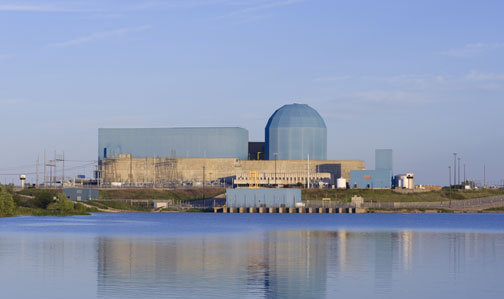Brexit and the Future of British Nuclear Power
by Andrew Reimers
Your most critical assets deserve more than just fences and cameras. NV5’s cutting-edge layered security solutions extend detection and response beyond traditional perimeters. From advanced geospatial analytics to integrated surveillance and access control, NV5 helps you stay ahead of threats before they breach your defenses. Learn more.
by Andrew Reimers
On Wednesday, ANS Nuclear Cafe published a piece on Small Modular Reactors. Today, we present a short video covering some of the progress on Argentina's CAREM SMR, which was featured some time ago right here on this blog when the project to build it was launched.
As of this year, more and more developing nations around the world are actively considering nuclear power as a practical energy solution. Taking into account the looming depletion of fossil fuels and rapidly worsening impacts of climate change, the benefits of nuclear are becoming harder to ignore - as a safe, reliable and carbon-free source of energy, it's a viable path to growth for nations grasping at the chance of a sustainable future.
In recent years the allure of small, flexible, easy to construct and operate nuclear plants incorporating small modular reactors (SMR) have continued to grow for a host of reasons. Here in the United States, we've watched the saga of the SMR unfold fairly slowly over the last few years, as companies have entered the fray to various levels of success and have achieved varied degrees of progress.* Now, the latest large step in getting these small and versatile reactors into the worldwide commercial market has been taken - by an effort involving Saudi Arabia and South Korea.

Kansai Electric Power's Takahama Nuclear Generating Station. Unit 1 and 2 are on the right; Units 3 and 4 are in the background on the left. Courtesy Kansai Electric Power.
On July 12, the Otsu District Court in Japan made a significant decision regarding the future of Kansai Electric Power's Takahama nuclear station when it upheld a previous lower court injunction against the operation of Units 3 and 4 at that site. The district court had received a petition from just over two dozen intervenors in Shiga Prefecture earlier this year; legal wrangling ensued, with Kansai Electric filing an objection which ultimately today appears to have fallen on deaf ears. As it now stands, there is a provisional injunction against the startup of these two plants.
I recently had a conversation with Jessica Lovering about her article, "Historical Construction Costs of Global Nuclear Power Reactors," and the subsequently published replies to that article written by various authors, including Professors Jonathan Koomey and Benjamin Sovacool.
by Will Davis; information for this report obtained both from the 2016 ANS Annual Meeting session on Prototype Gen-IV Reactors and from representatives of the Korea Atomic Energy Research Institute (KAERI), its subsidiary Sodium-cooled Fast Reactor Development Agency (SFRA), KEPCO Engineering & Construction,+ and Argonne National Laboratory.
The year 2015 has gone down as the hottest year on record, thanks to the closing of nuclear power plants.

Perkins Nuclear Station layout as depicted in "Design Data and Safety Features of Commercial Nuclear Power Plants, Vol IV," Oak Ridge Nat'l Labs/Nuclear Safety Information Center, March 1975.
It is a common myth today that all of the nuclear plants historically ordered in the United States were unique, custom design and construction jobs. Many of the plants were built from standardized design drawings developed by established architect-engineer (A-E) firms in order to ease the work load and speed up progress on individual projects. In such cases, standard nuclear plant drawings were the basis for any given project the A-E took on. Over time, incremental changes were made in the drawings and of course customer-specific and site-specific changes needed to be made, as well as specific adaptations made for the nuclear steam supply system (NSSS) ordered by the customer. Stone & Webster as well as Sargent & Lundy were just two of the A-E firms that developed and used standard drawings, leading to there being a number of very similar nuclear plants in different places, built for different owners. Some projects, however, were even more repetitive than these.
Opinion by Will Davis for ANS Nuclear Cafe.
June is National Safety Month, an initiative of the National Safety Council. For more than 100 years, this organization has worked to promote awareness and further safety advocacy efforts to reduce accidental injuries and deaths throughout the United States. Preventing avoidable disasters is important in all energy industries, but it takes special precedence in the field of nuclear power.
by J.H. Stewart Melville III
Today's panel at the ANS 2016 Annual Meeting on hybrid energy systems might seem at first like somewhat of a misplaced effort, but it's certain judging by the varied content provided at this and other sessions this week as well as by comments of varied experts that grid flexibility will be the "name of the game" as time goes on. Hybrid energy systems, which combine more than one "prime mover" or energy generating source, may be one key to making it possible for nuclear energy to stay in the US game in the long term.

Used nuclear fuel storage; photo courtesy Oak Ridge National Laboratory, a division of the US Department of Energy
An interesting session at the ANS 2016 Annual Meeting, sponsored by the Fuel Cycle & Waste Management Division, saw the presentation of a number of interesting papers relative to the ever-increasing problem of used nuclear fuel at the various commercial nuclear plant sites in the United States. Not only does the used fuel (which is a far better term than "spent fuel," these days, since it can conceivably be reused) continue to accumulate at the nuclear plants, but there is also a considerable amount of used fuel being stored at various sites where the nuclear plants have actually been shut down, decommissioned and completely removed for years. Considering this, and the need to inventory, characterize and eventually move this material, a growing amount of interest is being shown in this field.

Today's panel discussion entitled New Nuclear Construction Around the World and which was chaired by past ANS President Ted Quinn, featured some solid information on the state of nuclear energy today. Four speakers, plus one special guest speaker, presented to an interested and engaged audience.
The 2016 American Nuclear Society Annual Meeting kicked off today (Monday, June 13) in New Orleans with a wonderful set of presentations on a wide variety of topics. ANS President Gene Grecheck opened the session and reminded those assembled that his mantra has been "We need nuclear, and nuclear needs ANS," following up with some of the success stories that ANS has been a part of in the past year:
Please consider signing this petition: Keep America's Nuclear Power Plants Working for US!

Clinton Power Station, courtesy Exelon Nuclear
Yesterday, June 2, 2016, may have marked a watershed moment in the present day history of nuclear power plants in the United States, when two nuclear plants were selected by their owner for shutdown far in advance of their license expiration dates for economic reasons. The fast-moving pace of plants being shut down under similar economic circumstances (unbalanced energy markets that favor other forms of energy to the detriment of nuclear) signals a broken system that must be changed, now.
http://www.eenews.net/tv/videos/2134 Today's matinee: an OnPoint interview with pronuclear environmentalist Michael Shellenberger, as he discusses the benefits nuclear energy has on the economy and the environment.